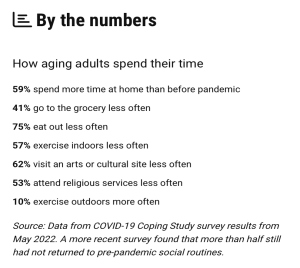By Calleigh M. Smith, Director of Communications Mobius Vendor Partners
COVID was five years ago, but it’s still something we hear and talk about almost every day. Not only did the shutdowns impact millions of people professionally, but they also kept us isolated from one another for weeks and months. Since then, we’ve learned that there’s a growing loneliness epidemic in this country.
The effects of COVID are still here, and now more than ever, it’s essential that we rely on our communities and recognize the power that belonging to one brings.
How many of us are still doing the majority of our meetings on Zoom, even when the people we’re meeting with are in the same city or even in the same office? We’ve become more comfortable remaining in isolated environments.
While the photo below focuses on aging adults, we’re seeing a similar trend across every demographic.

SNAP Benefits
We know that millions of people and children rely on SNAP Benefits to avoid going hungry. We also know that when a child is hungry, they can’t focus on school, learning, or anything else besides being hungry.
We saw the power of community over the past several days. Food pantries and community kitchens are overflowing with donations from those in their communities. Earlier this week, my mom and I went to donate food during a designated time at one of the centers in La Porte, Indiana. This is a center that also serves meals. It was lunchtime, and the building was packed. Not just packed with those needing assistance, but also with people willing to step up for their community’s most vulnerable.
Across the country, we’ve seen the same thing: neighbors helping neighbors, shelters preparing for the cold season, and local organizations rising to meet growing needs. The strength of a community shines brightest when times are hard.
But it’s not just in our personal and home lives where community matters.
Business: Referrals and Connection
The way we do business has changed since COVID. We’re seeing more solo entrepreneurs and people working independently (including myself). The way we collaborate is now different, often slower, less spontaneous, and sometimes less creative.
When looking at organizations:
Nearly 1 in 4 (22%) reported that working from home hurt their creativity, and 26% of managers agreed. Seventeen percent of workers said their work was less creative overall. Even managers weren’t immune: 38% of C-suite executives said they were slower to make decisions and take action since working from home, and 28% said they struggled to innovate.
Many cited isolation as the cause: 46% said they had less face time with their teams, 44% felt like they were working in a bubble and didn’t know what colleagues were doing, and 40% said collaboration on calls was harder. Nearly 1 in 4 managers said the drop in creativity came from losing whiteboard brainstorming sessions and similar in-person collaboration.
When looking at solo entrepreneurs:
Working by yourself can be a liberating but lonely experience. When you used to head to work, grab coffee, and interact with multiple people a day, you were surrounded by energy. Now, you might spend the entire day alone, with few meetings and little interaction.
We’ve seen co-working spaces become more popular, and groups like CoLab AE have been formed to meet this need.
Community is essential. Think about it: when somebody you trust gives you a recommendation versus when you see an ad on social media, which do you trust more? When we aren’t connected to our communities, we’re missing out on one of the most valuable resources we used to rely on.
Being around people 40 hours a week can be exhausting, but being isolated for 40 hours a week isn’t good either. As we head into the holidays, I encourage you to look around at your community and embrace it. Meet one more person for coffee than you normally would, or reach out to a colleague for a collaborative work session.
Creativity thrives when people connect.
Let’s bring that back.



